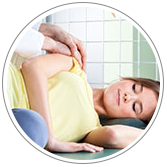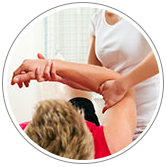Degenerative Disc Disease Treatment Options

Degenerative disc disease (DDD or DJD) is a common medical condition that affects a large and growing portion of the population. In fact, the low back pain that often accompanies DDD is the leading cause of disability in people under age 45. DDD has long been recognized as a difficult condition to treat, and many patients undergo invasive, expensive and risky surgical procedures every year in an attempt relief.
Part of the reason DDD can be difficult to treat is that disc degeneration itself is not a distinct diagnosis. Rather, DDD refers more generally to a breakdown of the spongy cartilage discs that separate and cushion the vertebrae. This breakdown is most often caused by normal changes that occur as part of the aging process. A majority of people experience these changes pain-free, and an estimated 85 percent of the population show evidence of some disk degeneration by the time they reach age 50. This means that there are two important things to keep in mind when it comes to degenerative disc disease:
- Most people will eventually have disc degeneration even if they do not have symptoms.
- Even if some degeneration is apparent in diagnostic imaging (X-ray) does not necessarily mean that DDD is actually responsible for your symptoms (pain, reduced mobility, etc.).
CONSERVATIVE TREATMENT OPTIONS
At the more conservative end of the spectrum, traditional treatment of DDD usually involves finding ways to manage the pain. The most common of these is taking non-steroidal painkillers such as aspirin, ibuprofen or acetaminophen. However, this does not ultimately address the cause of the problem. The good news is that there are other conservative options available.
Many patients have found that manual therapies, such as chiropractic care and therapeutic low back massage can improve mobility and reduce pain without the need for medication. These approaches center on restoring blood flow, easing inflammation, reducing muscle tension and increasing range of motion. They can also stimulate the release of pain-relieving natural endorphins.
Non-surgical spinal decompression therapy (inversion therapy, Cox flexion-distraction technique) has also proven to be effective for many patients. This treatment involves gently separating the vertebrae to reduce pressure on the spinal discs and encourage nutrients and water to flow back into them.
SURGICAL OPTIONS
Surgical options range from minimally-invasive procedures like microdiscectomies to more invasive ones such as laminectomies and spinal fusions. Under certain circumstances, surgery may help relieve the pain caused by DDD and related pressure on nerves. While these types of techniques have become increasingly common, they all involve the risks that accompany any type of surgery.
Always be sure to consult your family physician and be sure to get a second (and third) opinion before undergoing any type of surgery. They can help you balance the likelihood of success against the risks and expense. Most healthcare professionals recommend that patients exhaust more conservative treatment options before choosing surgery.
EXPERIMENTAL TECHNIQUES – A LOOK INTO THE MORE DISTANT FUTURE?
Medical researchers and clinicians around the world are experimenting with other approaches to treating degenerative disc disease. Two of the more promising candidates include stem cell therapy and disc replacement. While both of these techniques are in the very early stages of development, they may eventually prove useful for the small percentage of people for whom conservative therapies have not worked on a long-term basis.
Stem Cell Therapy
Some scientists are investigating the possibility of using stem cells to either restore the integrity of the disc or to prevent the disc’s further degeneration. Researcher Helena Barreto-Henriksson of the Institute of Clinical Sciences, and her colleagues at the Sahlgrenska University Hospital in Sweden found that when stem cells were injected into a damaged disc in animal models, they showed some healing capacity. According to Barreto-Henriksson, “Images taken by MRI showed that the transplanted stem cells survived, that they developed into cells that had a function similar to that of disc cells, and that there was a certain degree of healing in the disc.”
A similar recent study explored the use of notochord cells, which are the precursors of intervertebral discs that are present in all vertebrates, and which have been found to survive into adulthood in some animals. A study performed on adult dogs found that these cells secreted a connective tissue growth factor (CTGF), which keeps cartilage healthy and flexible. If these cells can be found in the human vertebrae, therapies may be developed that would provide a simpler and better solution to treating DDD rather than surgery.
Disc Replacement
In more severe cases where surgery is necessary, it may soon be possible to replace individual vertebral discs. Engineers from Brigham Young University in Utah have recently developed an artificial spinal disc that is able to replicate the natural motion of the spine. Implanting this or a similar device may eventually be preferable to the current generation of surgical options.
A USEFUL PERSPECTIVE ON SPINAL HEALTH
While this article offers a very general look at some of the treatment options available for degenerative disc disease—today and perhaps in the future—it would be an oversight not to mention some of the things you can do to slow the rate of disc degeneration and reduce its likely effects.
- Develop and maintain “core” muscle strength. Strong back and abdominal muscles help support your frame and reduce the likelihood of injury.
- Watch your posture.
- Drink plenty of water to stay hydrated. Your discs are mostly water, and they work best as shock absorbers when they are at maximum volume and thickness.
- Stay active. Movement encourages the flow of fluid and nutrients into spinal discs.
With a growing segment of the population beginning to reach old age, both scientists and practitioners will continue to look for more and better solutions to age-related problems such as DDD. That said, it’s more important than ever for individuals to understand the role that their own lifestyle choices play in maintaining their health. These choices start with good nutrition, exercise and a basic awareness of biomechanics. Because prevention is always better than even the best cure…
A Woburn chiropractor with dedicated to serving the local community, Dr. Marc Moramarco is conveniently located just off 128 – I95 at Exit 35, near the Stop & Shop at 3 Baldwin Green Common. Dr. Marc serves patients from Boston’s north suburbs including Burlington, Wilmington, Reading, North Reading, Winchester, Stoneham, Lexington, Wakefield, Lynnfield, Andover, Medford, Bedford and beyond. Call today at 781-938-8558 to schedule your appointment.
We take the best possible care of every patient who walks through our doors!
The best nonsurgical Scoliosis treatment available in North America!
We'll help you diagnose what's wrong and get you back to your life.


